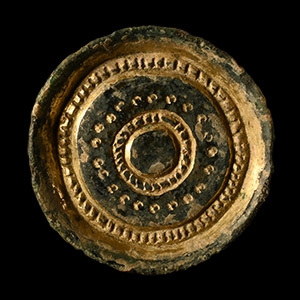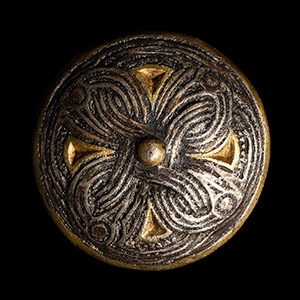Home > Auctions > 5 - 9 March 2024: Ancient Art, Antiquities,
Natural History & Coins
Auction Highlights:
Acquired in the early 1980s.
with Edward Smith, USA.
From the collection of a Connecticut, USA, collector.
with TimeLine Auctions, 23 May 2017, no.251.
Private American collection, New York, USA.
Accompanied by an academic report by Dr Raffaele D'Amato.
This lot has been checked against the Interpol Database of stolen works of art and is accompanied by search certificate number no.11994-210999.
Cf. Tassinari, S., La vaiselle de bronze, Romaine et Provinciale, au musée des antiquités nationales, Paris, 1975, fig.20, for a similar handle; Mattusch, C.C., Pompeii and the Roman Villa: Art and Culture Around the Bay of Naples, Washington, 2008, item 30, for type; for decoration and similar types in Britain see PAS WMID-3FE965, LVPL-39BCF5,YORYM-20B68C.
This could be an example of a Romano-British bronze and enamel handle from a mirror or patera, similar to some other existing examples in museums. The shape of the handle is similar to one of the famous pateras from Pompeii. Our specimen is decorated with 'Celtic-style' motifs consisting of a curvilinear scrollwork design of turquoise and blue enamel. A bowl with almost identical enamel work was found in Staffordshire, known as 'The Staffordshire Pan' (WMID-3FE965), while a complete patera was excavated in Amiens (known as the Amiens Patera).
Found East Anglia, believed Cambridgeshire, UK.
From a collection acquired on the UK art market from various auction houses and collections mostly before 2000.
From an important Cambridgeshire estate; thence by descent.
Accompanied by a copy of Drandaki, A., "ΥΓΙΕΝΩΝ ΧΡΩ KYPI(E)" A Late Roman brass bucket with a hunting scene.
See Mango, Mango, Evans & Hughes, A 6th century Mediterranean bucket from Bromeswell Parish, Suffolk, in Antiquity 63, 1989, pp.295-311; Carver, M., Sutton Hoo. A Seventh Century Princely Burial Ground and its Context, London, 2005, p.485-7; Drandaki, A., "ΥΓΙΕΝΩΝ ΧΡΩ KYPI(E)" A Late Roman brass bucket with a hunting scene published on Academia.edu.
The vessel is of an unusual type: three have been found in Turkey, Italy and Spain, three in England (excluding the present examples) and three others have unknown findspots; this find brings the total of known examples to ten. The rarity of these vessels indicates the high status of their owners. Each of these buckets is decorated with a hunting frieze and most have an inscription in early medieval Greek. Their manufacture is so similar that it is thought that they were produced at a single workshop in the Eastern Empire, possibly at Antioch, in the 6th century AD (Drandaki, n.d.). Their exact use is not certain, but since several of the inscriptions refer to 'good health' this suggests a domestic setting related to bathing. The rounded object held by figure (6) is clearly based on a similar rounded clump which appears on the vessel in Benaki Museum (beneath the word ' KAΛOI') where it is more convincingly executed with a hatched fill (Drandaki, p.39). Only three examples of this type of vessel are previously known from England: one from Bromeswell, Suffolk, within 1 km of the Sutton Hoo cemetery, found in preparatory work for the Sutton Hoo Visitor Centre; one from Chessell Down, Isle of Wight, where the bucket was part of a rich female grave excavated in the 19th century; one from Breamore, Hampshire, found by metal-detectorist, and excavated by Hampshire County Council's archaeology team who discovered that the grave in which it was found formed part of an important early Anglo-Saxon cemetery. The excavation was filmed by Channel 4's Time Team in August 2001; the cemetery held six more burials with bronze containers, though none as grand as this Byzantine example.
Found East Anglia, believed Cambridgeshire, UK.
From a collection acquired on the UK art market from various auction houses and collections mostly before 2000.
From an important Cambridgeshire estate; thence by descent.
See Mango, Mango, Evans & Hughes, A 6th century Mediterranean bucket from Bromeswell Parish, Suffolk, in Antiquity 63, 1989, pp.295-311; Carver, M., Sutton Hoo. A Seventh Century Princely Burial Ground and its Context, London, 2005, pp.485-7; Drandaki, A., "ΥΓΙΕΝΩΝ ΧΡΩ KYPI(E)" A Late Roman brass bucket with a hunting scene published on Academia.edu.
The vessel is formally similar to the group of bronze vessels believed to have been made in Antioch in the 6th century, which have been recovered from 6th-7th century grave fields in England (Carver, 2005; Mango et al, 1989) and from sites in the Mediterranean area (see Drandaki, n.d.). While it lacks the elaborate hunting scenes and Greek inscriptions of the more complex examples, it shows most of the same decorative and constructional features.
Ex English private collection, formed in the 1960s.
Acquired from Bonhams, London, 13 April 2011, no.245 (part).
From an important Cambridgeshire estate; thence by descent.
Accompanied by copies of the relevant Bonhams catalogue pages and the original Bonhams lot tag.
Found whilst searching with a metal detector near Dullingham, Cambridgeshire, UK, on Wednesday 4th October 2023, by David Pearson.
Accompanied by a copy of the British Museum's Portable Antiquities Scheme (PAS) report no.SF-E6203C, and the museum drawings.
Accompanied by a copy of a letter from the finder explaining the circumstances of finding.
This lot has been checked against the Interpol Database of stolen works of art and is accompanied by search certificate no.12076-211956.
See Hines, J., A New Corpus of Anglo-Saxon Great Square-Headed Brooches, London, 1997.
The individual elements of the design have parallels elsewhere in the corpus, and most are very similar to those on a brooch from Nassington (grave 33), pl.94(b) in Hines, 1997. The headplate is very similar in general although the Nassington example shows more punchmarks and tooling, and its lateral lobes and disc finial all bear guilloche detailing whereas those on the present example are plain. Large discoid finials to the footplate are not uncommon (e.g. from Ipswich and Bury St. Edmunds on Hines's pl.58) but the pelta-shaped extension appears to be unique; the ribbed cross in the circle as found on the finial is parallelled by the brooch from Chessel Down (Hines's pl.13(b)).
Found whilst searching with a metal detector near Driffield, East Riding of Yorkshire, UK, in 2018.
Accompanied by a copy of the British Museum's Portable Antiquities Scheme (PAS) report no.YORYM-73B821.
This lot has been checked against the Interpol Database of stolen works of art and is accompanied by search certificate no.12075-124454.
See Portable Antiquities Scheme, YORYM-975799, for a similar example.
Found whilst searching with a metal detector in Bassetlaw, Nottinghamshire, East Midlands, UK, from Tuesday 1 January to Wednesday 1 May 2013.
with TimeLine Auctions, 23 May 2017, no.494.
Accompanied by a copy of the British Museum's Portable Antiquities Scheme (PAS) six page report with refence no.DENO-4207C5 and is designated as 'a find of note'.
This lot has been checked against the Interpol Database of stolen works of art and is accompanied by search certificate no.12077-210997.
See Arrhenius, B., Merovingian Garnet Jewellery, Stockholm, 1985; Bourke, C. Irish Croziers of the Eighth and Ninth Centuries in Ryan, M. (ed.) Ireland and Insular Art AD 500-1200, Dublin, 1987; Webster, L. & Backhouse, J., The Making of England. Anglo-Saxon Art and Culture AD 600-900, London, 1991; Laing, L. A Catalogue of Celtic Ornamental Metalwork in the British Isles c.AD 400-1200, BAR British Series 229, Oxford, 1993, item 244 (Steeple Bumpstead boss); Carver, M., Sutton Hoo. A Seventh Century Princely Burial Ground and its Context, London, 2005.
This mount is unusual, although its decoration and manufacturing techniques point to an origin in the British Isles in the 7th-9th centuries. Its D-shaped upper face or ledge indicates that it is not the standard flat form of scabbard or harp fitting. The openwork nature of the casting is equally unusual, although the Steeple Bumpstead boss (British Museum accession no. 1916,0705.1) is formed with an openwork frame into which gilt bronze panels have been inserted, and several Irish croziers were manufactured in this manner (Bourke, 1987). The cells were probably intended to accept a glass inset gem, or an ivory or millefiori panel, although the inner panel of the central cell shows signs of having been gilded as if to reflect light through a translucent gem in the same manner as the foils placed behind the garnets on 6th-7th century Anglo-Saxon jewellery and weapon-fittings (Arrhenius, 1985; Carver, 2005). The beasts (especially the upper pair) show strong Irish influence in their design, which is found elsewhere in Northumbrian art in the 8th-9th century as for example on the brow fittings of the Coppergate helmet (Webster & Backhouse, item 47). Similar heads in profile appear on the scabbard chapes from the St. Ninian's Isle Treasure (Wilson, plate IV). The overall design of the piece is tentatively identified with the 'fish flanked by birds' motif seen for example in the Staffordshire Hoard, probably of later 7th century date.
Found by Steve Aldred whilst searching with a metal detector near Ferryhill, County Durham, UK, on Tuesday 8th March 2022.
Recorded with the British Museum's Portable Antiquities Scheme (PAS) and subsequently returned to the finder.
Accompanied by a copy of the British Museum's Portable Antiquities Scheme (PAS) report no.DUR-834DAB, where this object is described as: 'a find of note and has been designated: of National importance'.
Accompanied by a copy of the article about the circumstances surrounding the finding published in the February 2024 issue of Treasure Hunting Magazine.
Accompanied by a copy of a photograph taken of the object when it was found on 8th March 2022.
This lot has been checked against the Interpol Database of stolen works of art and is accompanied by search certificate no.12074-214165.
See Williams, D., Late Saxon Stirrup-Strap Mounts: a classification and catalogue: a contribution to the study of Late Saxon ornamental metalwork, 1997; Council for British Archaeology Research Reports no.111; and Wilson, D.M. and Klindt-Jensen, O., Viking Art, London, 1966.
The Hotspot, Treasure Hunting Magazine, February 2024, News and Views, p.12 & 13.
Comparison has been made with stirrup-strap mounts of Williams (1997) Class A, Type 9, and especially with variants of the form (see HAMP-B7C312). Although relatively few of these mounts have been found, and their distribution is spread across the country, there is an arguable focus on Yorkshire. Commenting on a 2007 Isle of Wight example (IOW-4FA904), Barry Ager (then of the British Museum) suggested a connection with horse-riding equipment, and in particular drew comparisons with a type of face-mask mount on the Danish harness-bow from Søllested (see Wilson and Klindt-Jensen, pl. 37).
Acquired between the 1960s-early 1990s.
From an old UK private collector from Worthing, West Sussex, UK.
Property of K.P., a Cornish lady collector, UK.
Cf. Hattatt, R., Brooches of Antiquity, Oxford, 1987, item 1316, for type.
Found Cambridgeshire, UK.
Cf. MacGregor, A. & Bolick, E., A Summary Catalogue of the Anglo-Saxon Collections (Non-Ferrous Metals), Oxford, 1993, item 2.38, for type.
Ex German collection.
with Artemis Gallery, Colorado, USA, 8 March 2016, 58A.
Private American collection, New York, USA.
Accompanied by a copy of a previous typed catalogue page.
The style of the plaque is very heavily influenced by the Irish Book of Kells where confronted, interlaced figures appear as ornament.
Private collection formed in Europe in the 1980s.
Westminster collection, central London, UK.
Cf. Kershaw, J.F., Viking Identities. Scandinavian Jewellery in England, Oxford, 2013, pl.3, for type.
265 - 276 of 2726 LOTS

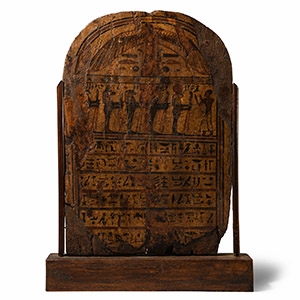
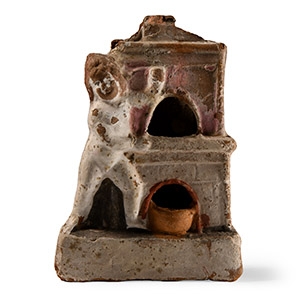

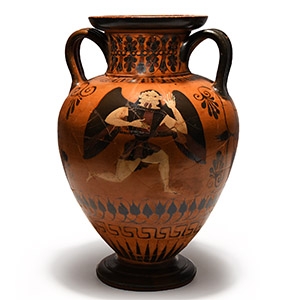
.jpg)
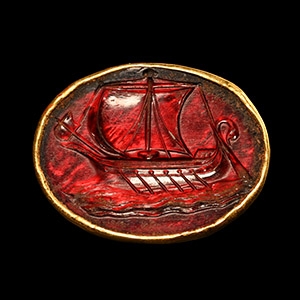
.jpg)

.jpg)
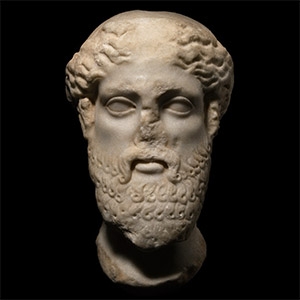
.jpg)
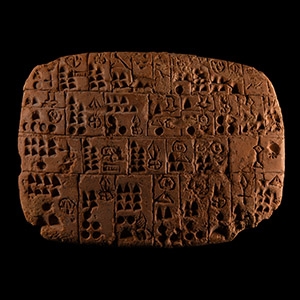

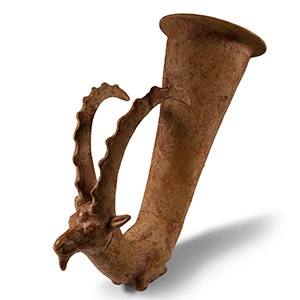
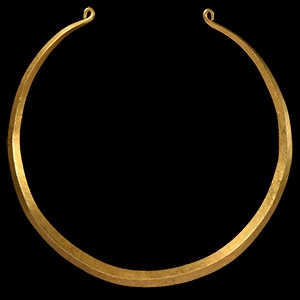
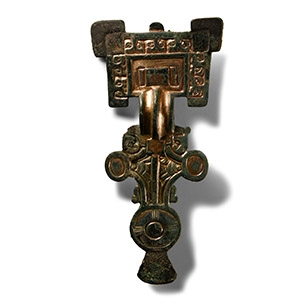
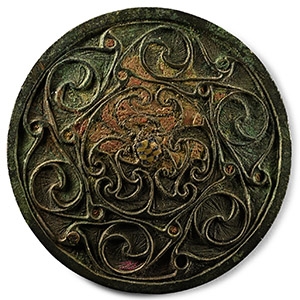

.jpg)
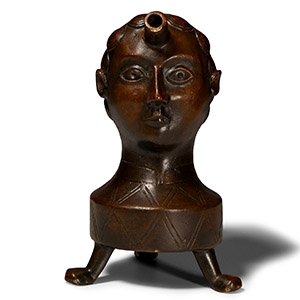
.jpg)

.jpg)
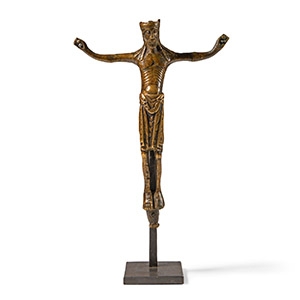

.jpg)
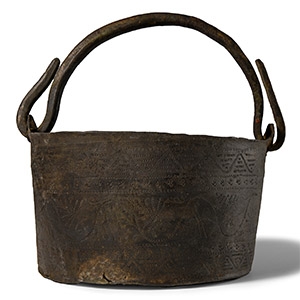

.jpg)

